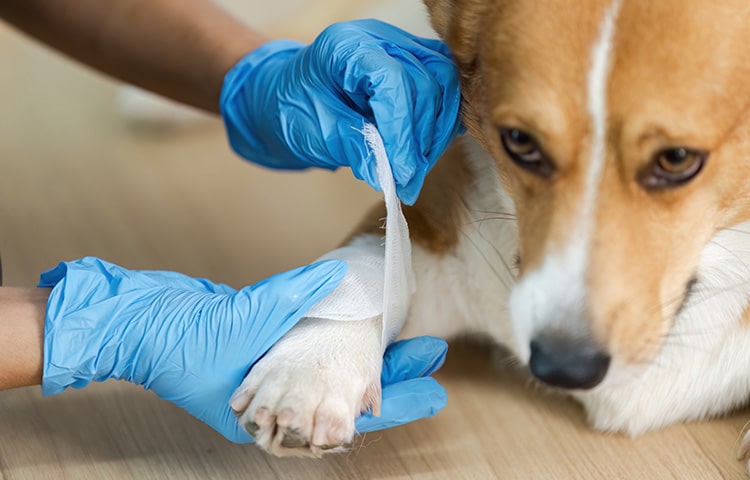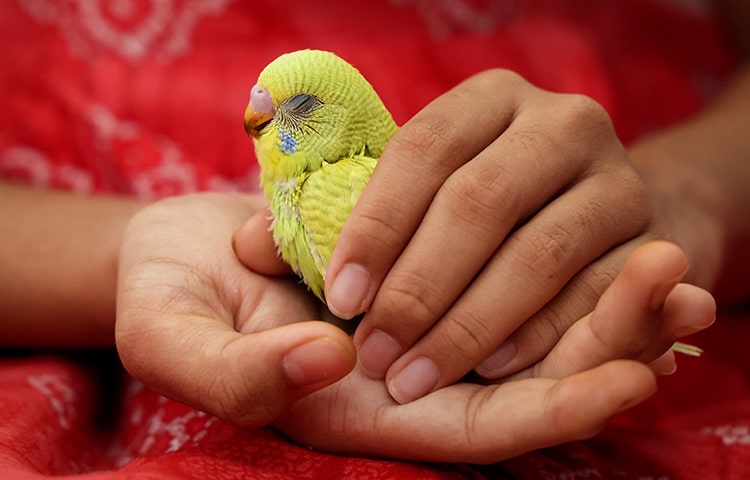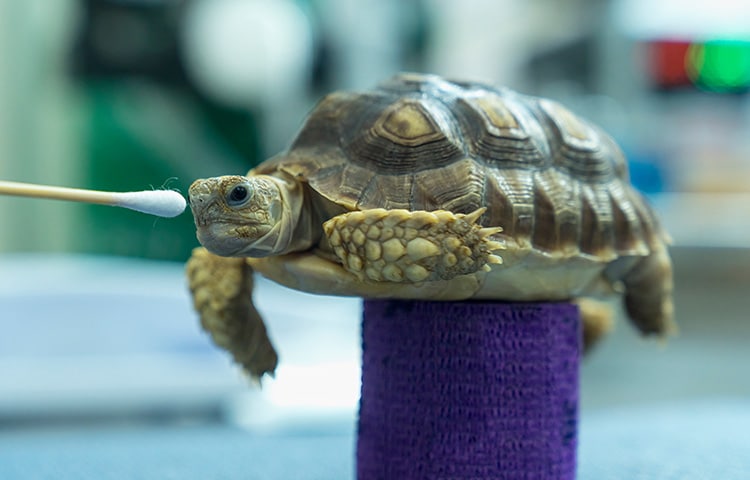Accidents can happen to our pets when we least expect them, during a walk, in the garden, or even at home. Would you know what to do if your dog cut their paw, your cat ate a toxic plant, or your pet started choking?
Knowing a few basic first aid steps can help keep your pet safe and comfortable until you can get your pet to a vet.
Jump to:
Common pet emergencies and what you can do
1. Bleeding or cuts
Pets often get cuts from sharp objects, broken glass, or rough play.
What to do:
- Apply gentle pressure with a clean cloth like a tea towel or bandage to stop the bleeding.
- If the cut is small, clean it with saline and cover it lightly.
- Keep your pet as relaxed as possible and call the vet straight away.
Tip: Do not use human antiseptic creams unless approved for pets as they can be harmful.
2. After a traffic accident
Pet accidents can happen in an instant and are some of the scariest emergencies you’ll face.
What to do:
- If they’re still on the road, move them to a safe space carefully using a blanket or a sturdy board.
- Check if your pet is breathing and look for injuries.
- Even if your pet appears fine, it’s important to contact your vet. Internal injuries aren’t always visible.
Tip: Always handle your pet gently. Pain or shock can make them react unpredictably.
3. Collapse or seizures
These episodes may happen suddenly and can be caused by heatstroke, poisoning, low blood sugar, or an underlying health condition. Staying calm and knowing what to do next can make a big difference.
What to do:
- Say their name to check if they respond
- If they’re having a seizure, don’t try to hold them down. Clear the surrounding area of any objects that could injure your pet during the episode.
- If you can, note how long the seizure lasts and record it for your vet.
- If the seizure lasts more than two minutes or happens more than once, go to the vet at once.
- Even after a short seizure, contact your vet for advice and a check-up.
Tip: Use your phone’s timer to track the duration of seizures, and make sure your vet’s number is saved in your contacts for quick access during emergencies.

4. Fracture or broken bones
A suspected fracture or broken bone is always an emergency. These injuries can happen after falls, car accidents, or even rough play.
What to do:
- Check for any swelling or unusual shape in the limbs.
- Avoid giving human medication or trying to splint the leg yourself.
- Keep your pet calm and still and contact your vet immediately.
Tip: Use a blanket or towel to gently lift and carry your pet when taking them to the vet. It can be more comfortable and help reduce any pain.
5. Choking or breathing issues
If your pet starts pawing at their mouth, coughing, gagging, or has difficulty breathing they could be choking, here’s what to do:
- If you can clearly see the object and it’s easy to reach, gently remove it with tweezers or your fingers. Do not try this if there is a risk of pushing the object further down.
- Call your vet and head to the clinic as soon as possible.
- If your pet collapses or isn’t breathing, you can try pet CPR. Give gentle rescue breaths by closing their mouth, extending their neck, and breathing into their nostrils. Keep in mind, this is often not very effective but can be worth trying.
Tip: Always keep an eye on what your pet is chewing on and avoid giving them toys or bones that could easily break or splinter. A little prevention can go a long way!
6. Poisoning
Poisoning is a common and serious issue. Everyday items like chocolate, grapes, raisins, onions, xylitol (found in sugar-free gum), antifreeze, and certain toxic plants can be deadly.
What to do:
- Call your vet or the Animal Poison Line for advice.
- Do not try to make your pet vomit unless your vet advises it. This might cause more harm.
- If possible, bring the packaging or a small sample of what your pet ate and show it to your vet.
Tip: Always keep toxic foods and chemicals out of your pet’s reach.
7. Burns
Pets can get burns from hot surfaces, boiling water, chemicals, open fires or even electrical cables and wires. They can also get sunburned on sensitive areas like ears and nose.
What to do:
- Move your pet away from the source immediately and clear the area of any hazards.
- Burns from scalding water, open fire or sunburn should be cooled with clean water.
- Burns from chemicals, like kitchen or bathroom cleaning products, need different care. It’s best to call your vet right away and follow their advice. The treatment will depend on how bad the burn is and what caused it.
Tip: To prevent sunburn, keep pets out of strong sunlight and use pet-safe sunscreen on exposed areas like ears and nose.

8. Heatstroke
UK summers may not seem extreme, but some dogs, cats, horses, small mammals or birds can overheat quickly, especially if kept in hot cars or during exercise.
Signs of heatstroke include heavy panting, excessive drooling, bright red gums, vomiting, weakness, and even collapse.
What to do:
- Move your pet to a cool, shaded area at once.
- Offer small amounts of water, never force them to drink.
- General advice is to apply cool (not icy) damp towels to their body, especially around the neck, armpits, and paws. But check our blog for more ways on keeping your pet cool during hot weather.

9. Bites and stings (snakes, insects, or other animals)
Pets can be stung by bees or other insects or even bitten by snakes and other animals while exploring outdoors.
What to do:
- Keep your pet calm and as still as possible to reduce the spread of venom or toxins.
- Avoid touching the bite wound unnecessarily.
- If your pet has been bitten by a snake or another animal, or stung by an insect, contact your vet at once for guidance.
- Carry your pet gently to prevent movement and get to the vet quickly.
Tip: Don’t try to suck out the venom or use a tourniquet as it can make things worse. If you’re unsure what to do next, our guide on adder bites has more detailed advice.
What to keep in a pet first aid kit
Having a dedicated pet first aid kit at home and in your car is essential. It helps you act fast when something goes wrong.
Here are the basics every kit should include:
- Sterile bandages and gauze – for covering wounds.
- Pet-safe antiseptic wipes – to clean small cuts.
- Tweezers – to remove splinters or debris.
- Saline solution – for rinsing eyes or wounds.
- Blunt-ended scissors – for cutting bandages safely.
- A clean towel or blanket – to keep your pet warm or carry them.
- Muzzle (for dogs) – even the gentlest of pets may bite when in pain.
- Contact details for your vet and local emergency pet hospital – save them in your phone and keep a written copy in your first aid kit so you can act quickly in an emergency.
Quick safety tips for UK pet owners
- Save your vet’s phone number and the nearest out-of-hours emergency vet in your phone.
- Keep your pet insurance details handy. It saves time in emergencies.
- Think about taking a basic pet first aid course from trusted pet groups.
- Carry a basic first aid kit for when you’re out and about.
Knowing basic first aid for pets can help you stay calm and take the right steps in an emergency. Start by preparing a pet first aid kit today and saving your vet’s number, you’ll be glad you did.


